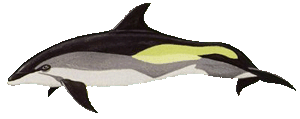|
|
|
|
|
Back to the main menu of species Atlantic Humpback Dolphin 
Scientific Name: Sousa teuszii Other Names: Atlantic Humpback Dolphin, Cameroon Length: 6.5-8.3 ft. (2-2.5 m.) Weight: 220-330 lbs. (100-150 kg.) Teeth: 100-126 The classification of the hump-backed dolphins is still in dispute,
however, most authorities currently accept only 2 species (the Atlantic Hump-Backed
dolphin and the Indo-Pacific Hump-Backed dolphin). Confusion is most likely with
the bottlenose dolphin, but with an elongated hump of fatty tissue in the middle of its
back and a relatively smaller dorsal fin, the Atlantic Hump-backed Dolphin is fairly easy
to recognize.
Spotted Dolphin 
Scientific Name: Stenella frontalis Other Names: Golf Stream Spotted Dolphin, Long Snouted Dolphin Length: 5.8-7.5 ft. (1.7-2.3 m.) Weight: 220-310 lbs. (100-140 kg.) Teeth: 122-166 The atlantic spotted dolphin is different from
the spinner dolphin and other spotted dolphins because it has a more robust body,
thicker beak and other smaller differences making it more similar to the bottlenose
dolphin. It is the most spotted of all dolphins and is extremely friendly and inquisitive.
These dolphins are also fast swimmers, using long shallow leaps as they go. Newborn
calves are born without spots and do not acquire them until they reach maturaty.
Atlantic White-Sided Dolphin 
Scientific Name: Lagenorhynchus acutus Other Names: Jumper Dolphin, Springer Dolphin Length: 6.3-8.3 ft. (1.9-2.5 m.) Weight: 365-440 lbs. (165-200 kg.) Teeth: 114-160 Atlantic white-sided dolphins are fairly large
and are very conspicuous at sea. They have short, thick stripes on each side of
their peducle, the color of which ranges from tan to yellow. They are avid bow
riders and often leap completely out of the water as they swim.
Black Dolphin 
Scientific Name: Cephalorhynchus eutropia Other Names: Chilean Dolphin Length: 4-5.8 ft. (1.2-1.7 m.) Weight: 65-145 lbs. (30-65 kg.) Teeth: 112-136 The black dolphin is a poorly know species.
They are believed to be unobtrusive. Black dolphins may be confused with the
spectacled porpoise or with the burmeister's porpoise. However, the dorsal fins
may be used to distinguish between the three species. These dolphins are illegally
hunted and killed to be used as bait for the king crab fishery in Chile. This is a
major concern because the population is unknown and could be very low.
Bottlenose Dolphin 
Scientific Name: Tursiops truncatus Other Names: Bottle-nosed Dolphin, Cowfish Length: 6.3-12.8 ft. (1.9-3.9 m.) Weight: 330-1440 lbs. (150-650 kg.) Teeth: 74-100 Bottlenose dolphins are some of the best
known species of dolphin. Many performing dolphins in zoos and aquariums are
bottlenose dolphins. These dolphins vary greatly in size, shape, and color from
one individual to the next. However, it appears that there are two main varieties:
a smaller inshore form and a larger, more robust offshore form. In general, they
are gray with darker backs than undersides. Bottlenose dolphins also have an
inquisitive and active behavior. They frequently lobtail, bow ride, wake ride, and
body surf. These dolphins are known to associate with other species of cetacea
as well as humans, sharks, and sea turtles. The distribution of bottlenose dolphins
range from cold temperate to tropical sea's worldwide.
Please dont forget to sign my guestbook as I love getting mail.Sign my Dreambook! |